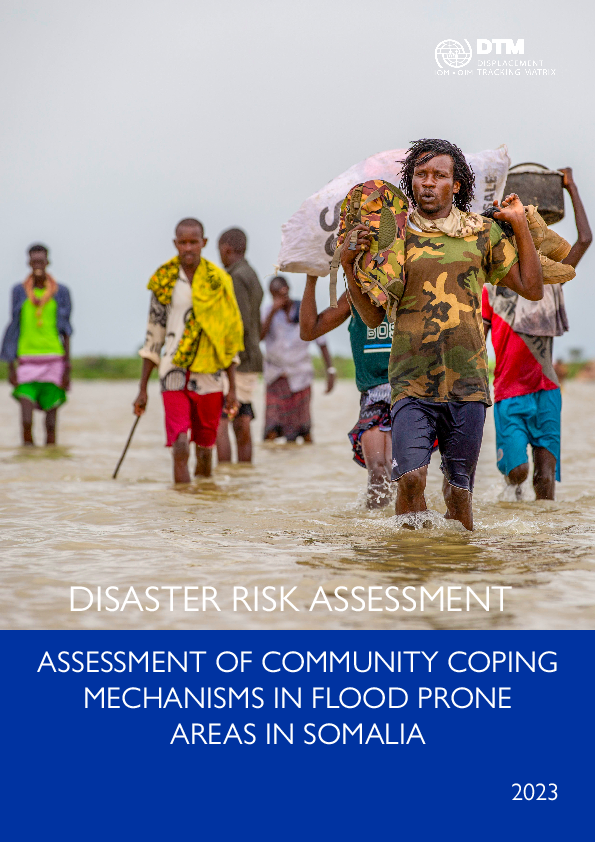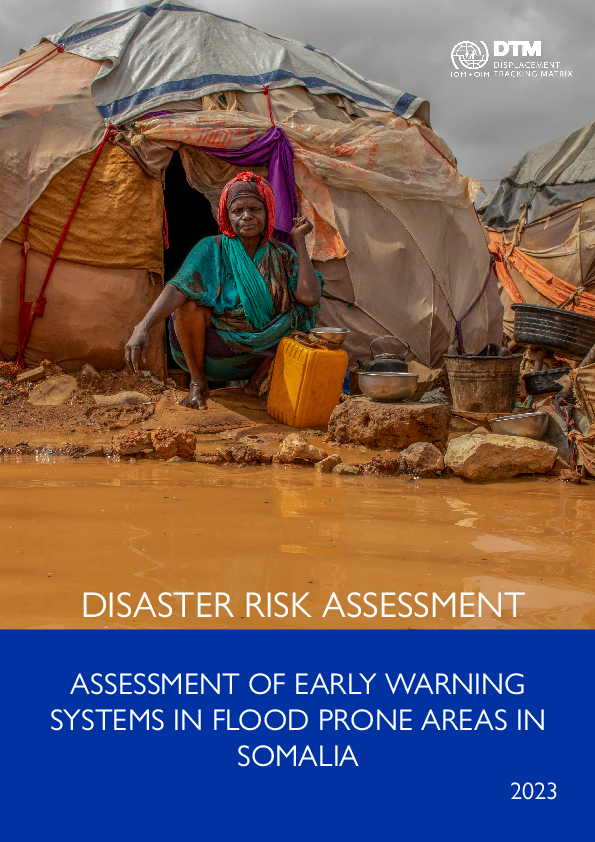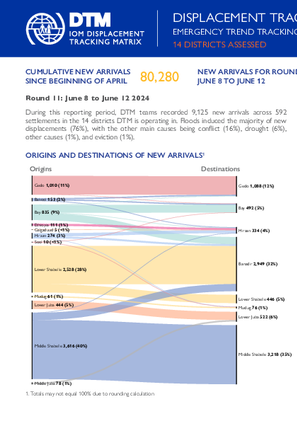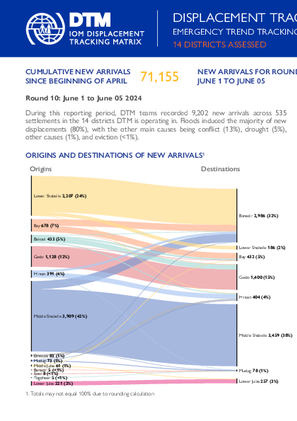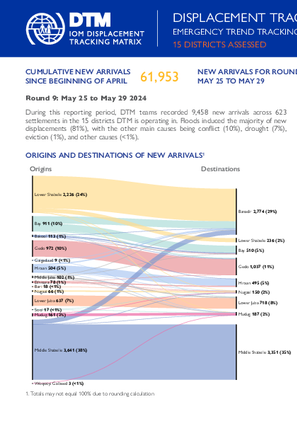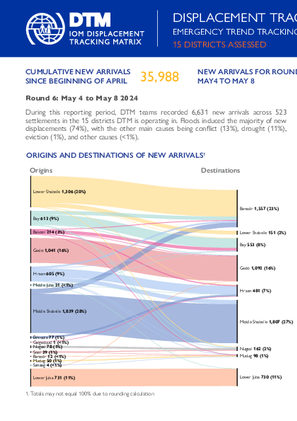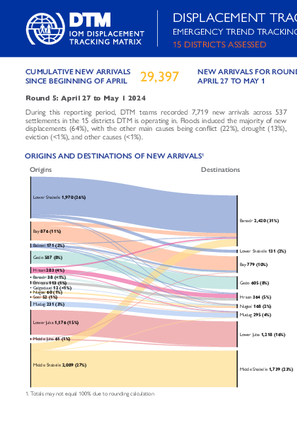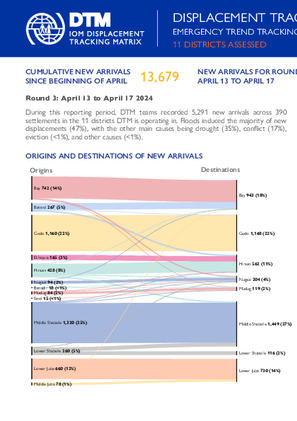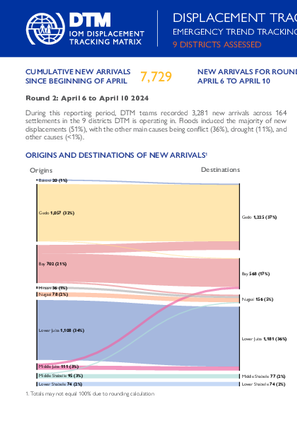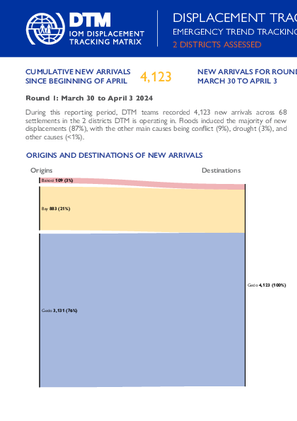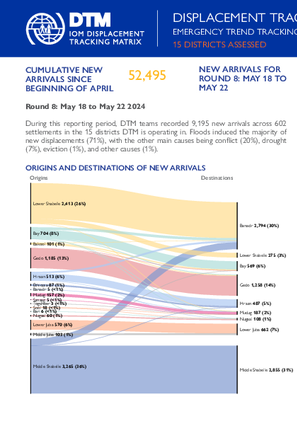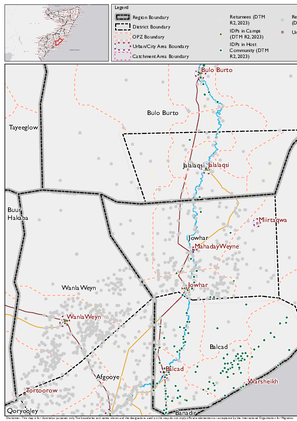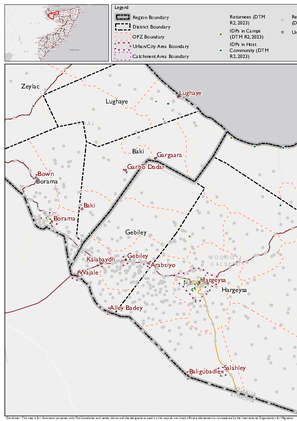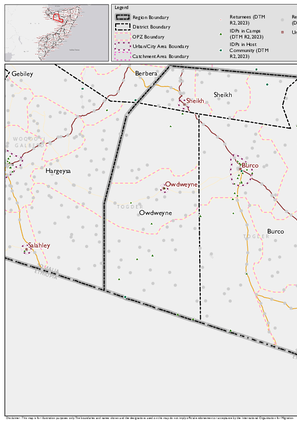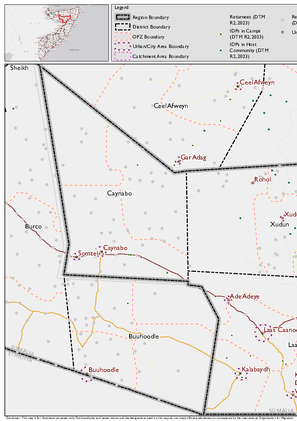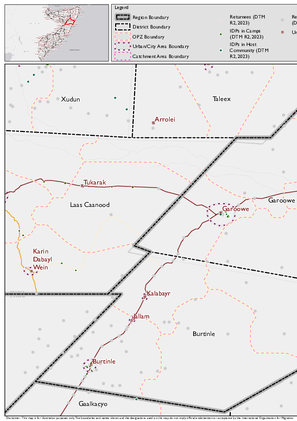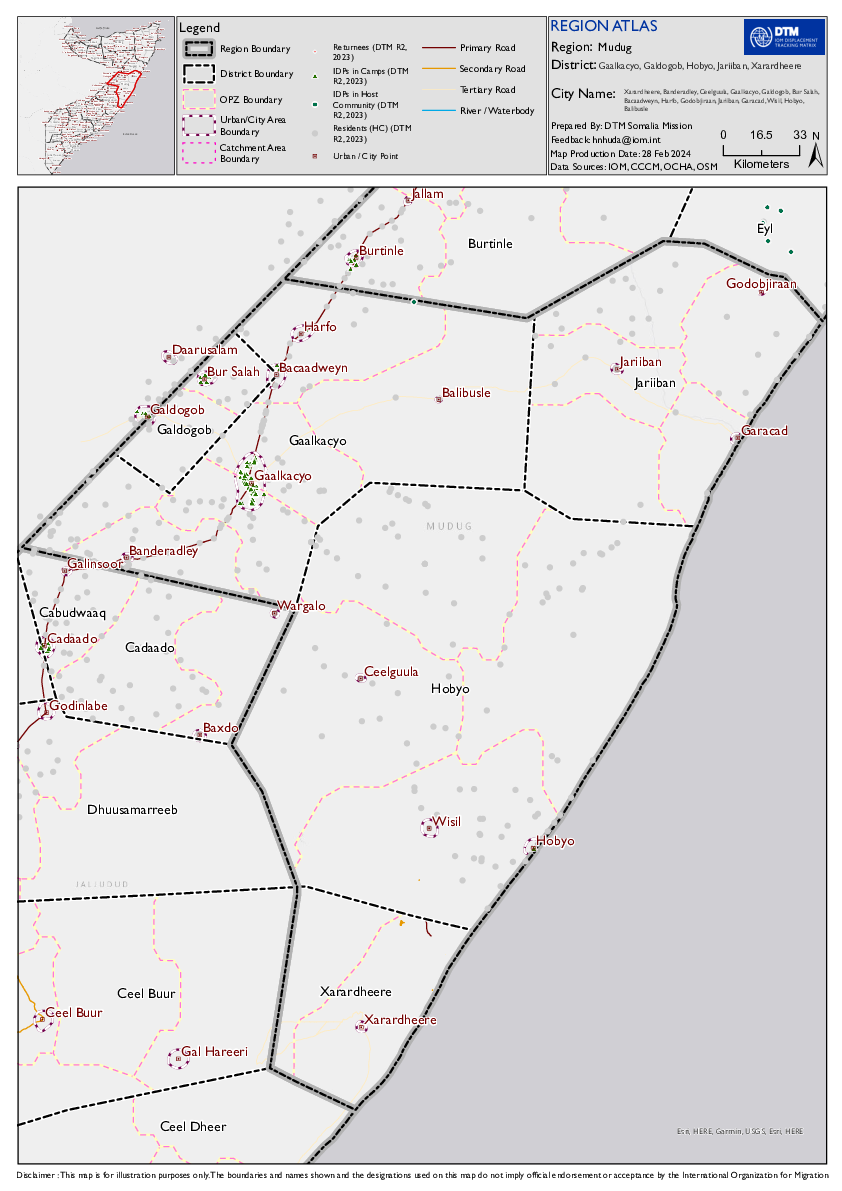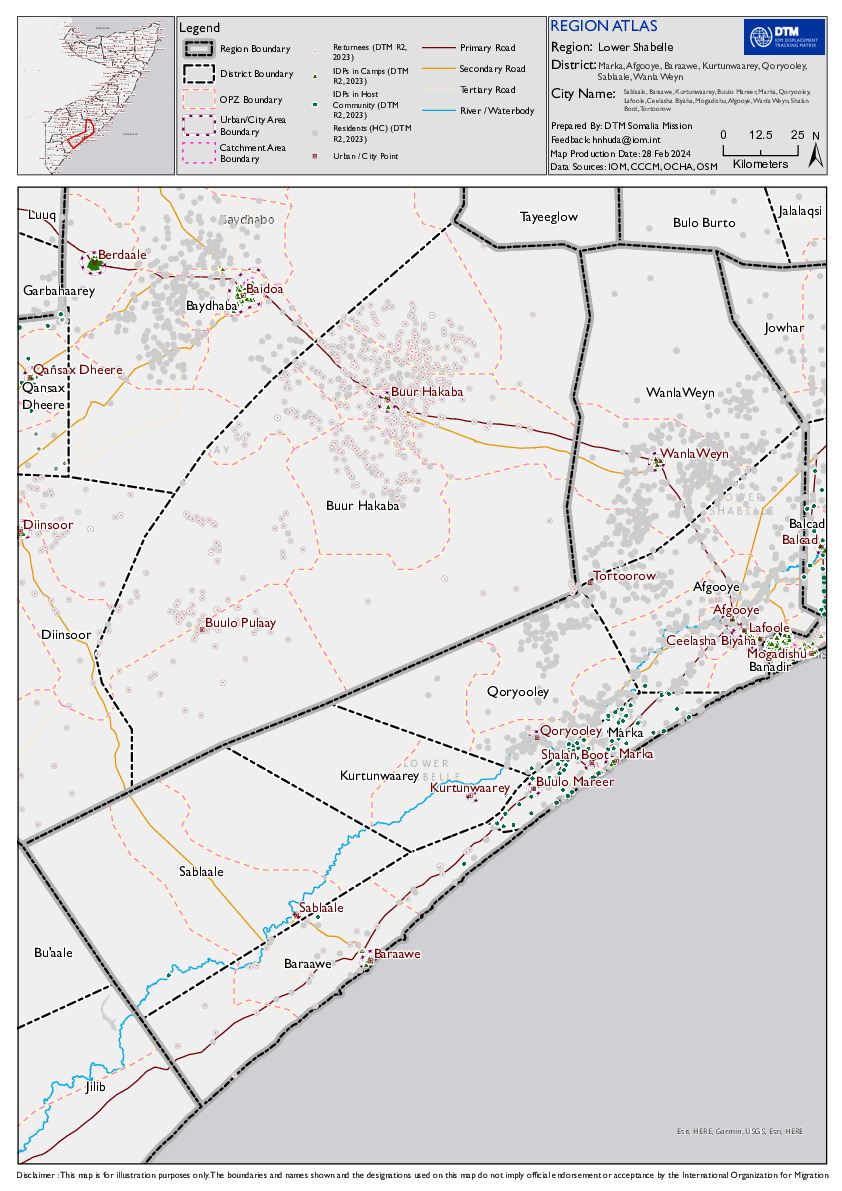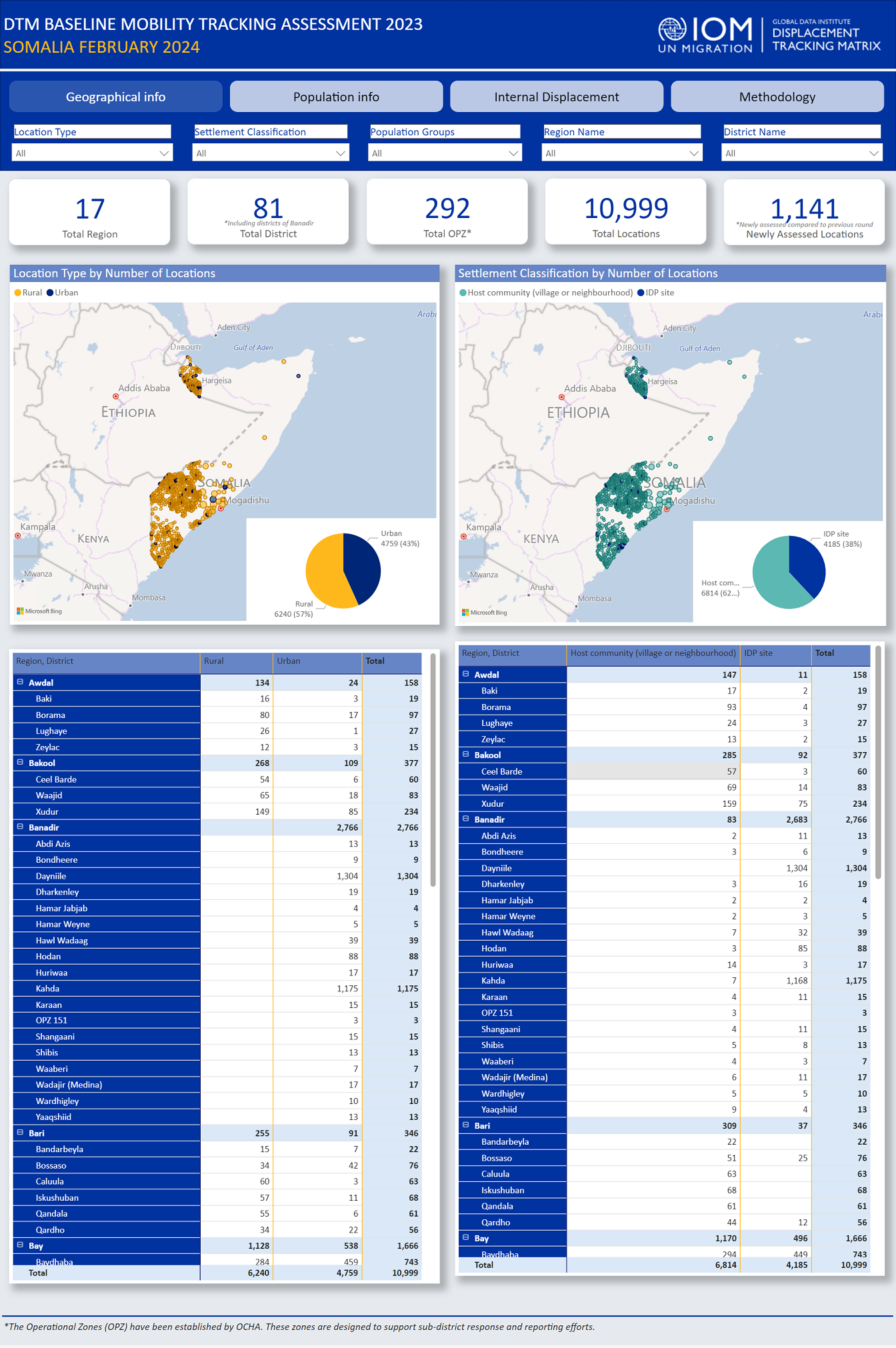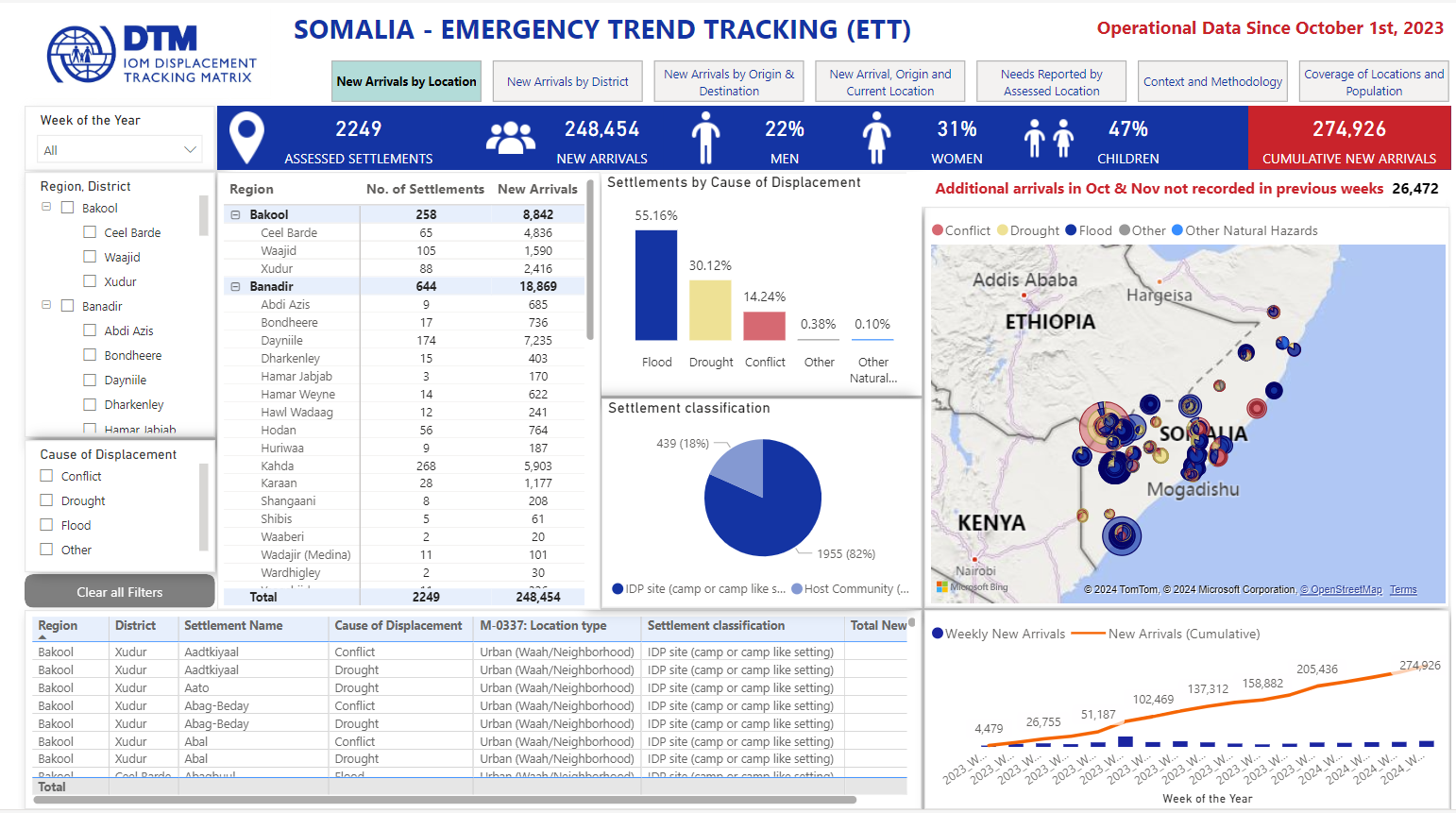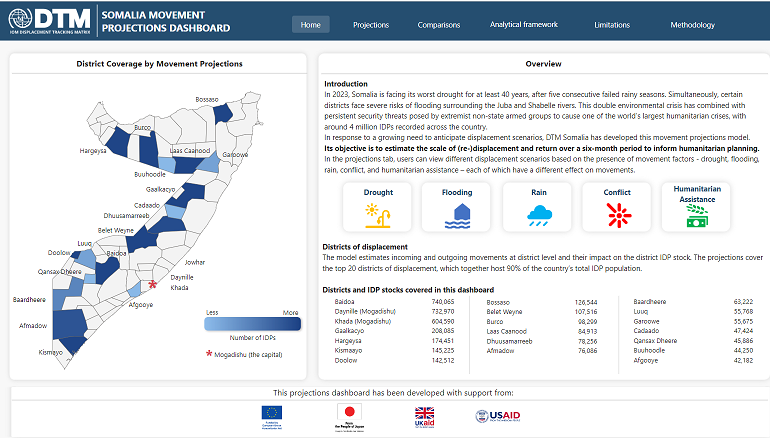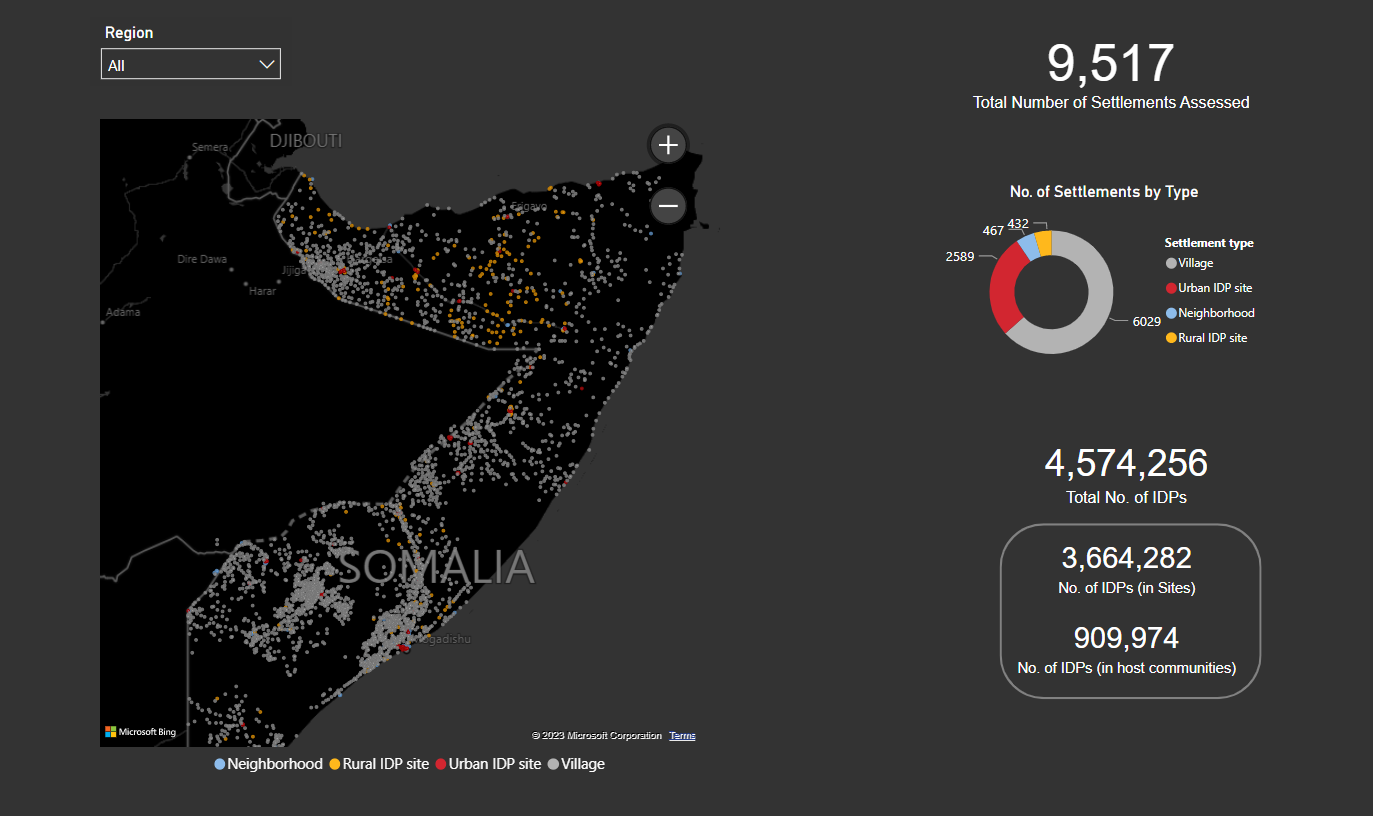-
Countries
-
Data and Analysis
-
Special Focus
-
Crisis Responses
Somalia
Somalia
IDPs tracked
Displacement Movements
3,862,000
IDMC 2023
Data collection round
About Somalia
IOM Somalia Displacement Tracking Matrix (DTM) aims to collect, analysis and disseminate information on displacement. DTM is IOM’s information management system to track and monitor numbers, locations, movements, needs and vulnerabilities of displaced people. The data outputs, including reports, maps, datasets and online interactive resources, support responses in humanitarian crisis, evidence-based decision making, durable solutions programming and migration research. DTM Somalia was first launch in 2016.
Since the collapse of the Somali central government in 1991, Somalia has suffered a highly complex protracted conflict characterized by changing political dynamics and power shifts. Forced displacement remains an ongoing reality for people living in Somalia due to conflict, environmental hardships, combined with inadequate resource distribution that is often exacerbated by clan-based, ideological differences and land and natural resource competition. Natural hazards, including drought and flooding, combined with widespread security threats have caused one of the world’s largest displacement crises, with 3.8 million IDPs recorded at the end of 2022. Somalia also has a strategic geographical position on the eastern route, which connects the Horn of Africa to the Gulf countries, representing one of the most dangerous and frequented migration corridors in the world.
Current Donors
- EU
- ECHO
- BHA
- Canada
- JSB
- World Bank
Somalia — Emergency Trend Tracking Report — Round 16 (July 2024)
This latest round of Emergency Trends Tracking was initiated in April 2024 to monitor displacements movements during the Gu rainy season.
Somalia - National Displacement Profile 2023
Following the release of the first edition of PROGRESS 2023 report, the Displacement Tracking Matrix (DTM) has compiled a series of National Displacement Profiles based on end of year 2023 figures.
Jul 24 2024
Somalia - National Displacement Profile 2023
Somalia — Border Point Flow Monitoring — (May 2024)
A total of 24,430 movements were observed in May 2024, representing 8% increase compared to April 2024 when 22,611 movements were observed during this period.
Somalia — Emergency Trend Tracking Report — Round 15 (July 2024)
This latest round of Emergency Trends Tracking was initiated in April 2024 to monitor displacements movements during the Gu rainy season.
Somalia — Emergency Trend Tracking Report — Round 14 (July 2024)
This latest round of Emergency Trends Tracking was initiated in April 2024 to monitor displacements movements during the Gu rainy season.
Somalia — Border Point Flow Monitoring — (April 2024)
IOM Somalia DTM’s flow monitoring team tracks migrant movements at seven active Flow Monitoring Points (FMPs) along the border with Ethiopia, Kenya, and Djibouti and at Bossa FMP on the coast.
Somalia — Border Point Flow Monitoring — (March 2024)
A total of 26,793 movements were observed in March 2024, representing a 35% increase compared to February 2024 when 19,813 movements were observed during this period.
Somalia — Border Point Flow Monitoring — (February 2024)
A total of 19,813 movements were observed in February 2024, representing a 6% decrease compared to January 2024 when 21,115 movements were observed during this period.
Somalia — Border Point Flow Monitoring — (January 2024)
A total of 21,115 movements were observed in January 2024, representing a 10% increase compared to December 2023 when 19,192 movements were observed during this period.
Somalia — Emergency Trend Tracking Report — Round 13 (June 2024)
During this reporting period, DTM teams recorded 6,070 new arrivals across 511 settlements in the 15 districts DTM is operating in. Floods induced the majority of new displacements (75%), with the other main causes being conflict (15%), drought (7%), other causes (2%), and eviction (1%).
Somalia — Baseline Assessment Summary Report (Hirshabelle, Jubaland, South-West State) — Round 3 (February – March 2024)
Somalia has experienced numerous conflicts, inter-communal violence, and natural disasters since the collapse of the Somali State in 1991. This has led to large recurring waves of forced displacement both within Somalia and into neighbouring countries and beyond.
Somalia — Baseline Assessment Regional Report (Hirshabelle, Jubaland, South-West State) — Round 3 (February – March 2024)
Baseline 2, an area-based assessment, is the second step of Mobility Tracking implemented at settlement level and aims to quantify presence of population categories.
Somalia — Emergency Trend Tracking Report — Round 12 (June 2024)
This latest round of Emergency Trends Tracking was initiated in April 2024 to monitor displacements movements during the Gu rainy season.
Somalia — Disaster Risk Assessment: Assessment of Community Coping Mechanisms in Flood Prone Areas in Somalia
The assessment of community coping mechanisms conducted during the El Niño period of 2023 sought to evaluate the strategies employed by communities impacted by flooding along River Juba and Shabelle.
Somalia — Disaster Risk Assessment: Assessment of Early Warning Systems in Flood Prone Areas in Somalia
The primary objective of this assessment was to evaluate the existence and effectiveness of early warning systems for enhanced disaster risk monitoring and reduction across 6 flood-prone districts in Somalia; Balcad, Baardheere, Beledweyne, Bulo Burto, Doolow and Jowhar.
Somalia — Emergency Trend Tracking Report — Round 11 (June 2024)
This latest round of Emergency Trends Tracking was initiated in April 2024 to monitor displacements movements during the Gu rainy season.
Somalia — Emergency Trend Tracking Report — Round 10 (June 2024)
This latest round of Emergency Trends Tracking was initiated in April 2024 to monitor displacements movements during the Gu rainy season.
Somalia — Emergency Trend Tracking Report — Round 9 (May 2024)
This latest round of Emergency Trends Tracking was initiated in April 2024 to monitor displacements movements during the Gu rainy season.
Somalia — Emergency Trend Tracking Report — Round 6 (May 2024)
This latest round of Emergency Trends Tracking was initiated in April 2024 to monitor displacements movements during the Gu rainy season.
Somalia — Emergency Trend Tracking Report — Round 5 (May 2024)
This latest round of Emergency Trends Tracking was initiated in April 2024 to monitor displacements movements during the Gu rainy season.
Somalia — Emergency Trend Tracking Report — Round 3 (April 2024)
This latest round of Emergency Trends Tracking was initiated in April 2024 to monitor displacements movements during the Gu rainy season. Districts covered in this round include Afgooye, Afmadow, Baardheere, Baidoa, Balcad, Belet Weyne, Gaalkacyo, Garoowe, Jowhar, Kismaayo, and Luuq.
Somalia — Emergency Trend Tracking Report — Round 2 (April 2024)
This latest round of Emergency Trends Tracking was initiated in April 2024 to monitor displacements movements during the Gu rainy season. Districts covered in this round include Afgooye, Afmadow, Baardheere, Baidoa, Balcad, Garoowe, Jamaame, Kismaayo, and Luuq.
Somalia — Emergency Trend Tracking Report — Round 1 (April 2024)
This latest round of Emergency Trends Tracking was initiated in April 2024 to monitor displacements movements during the Gu rainy season. Districts covered in this round include Baardheere and Luuq.
Somalia — Emergency Trend Tracking Report — Round 8 (May 2024)
This latest round of Emergency Trends Tracking was initiated in April 2024 to monitor displacements movements during the Gu rainy season. Districts covered in this round include Afgooye, Afmadow, Baardheere, Baidoa, Balcad, Belet Weyne, Gaalkacyo, Garoowe, Jamaame, Jowhar, Kismaayo, and Luuq.
Pagination
Somalia — Emergency Trend Tracking Dataset — (since April, 2024)
2024-07-17
<p>This latest round of Emergency Trends Tracking was initiated in April 2024 to monitor displacements movements during the Gu rainy season. Districts covered in this round include Afgooye, Afmadow, Baardheere, Baidoa, Balcad, Belet Weyne, Gaalkacyo, Garoowe, Jamaame, Jowhar, Kismaayo, and…
Somalia — Baseline Assessment (Hirshabelle, Jubaland and South-West State) — Round 3
2024-03-28
<p>Baseline 3, an area-based assessment that is part of Mobility Tracking implemented at settlement level and aims to quantify presence of population categories. DTM Somalia is administered&nbsp;across 7 regions and 29 districts in three states namely&nbsp;Hirshabelle, Jubaland, South…
Somalia — Emergency Trend Tracking Dataset — (since October, 2023)
2024-02-21
<p>In response to the Somalia’s severe drought beginning in November 2021, DTM Somalia launched an Emergency Trends Tracking (ETT) tool first in Gedo and Bay regions in 2022, and subsequently in Hiraan, Banadir and Middle Shabelle regions in 2023 to monitor drought related displacement trends…
Somalia — Baseline Assessment — Round 2
2024-01-31
<p>Baseline 2, an area-based assessment, is the second step of Mobility Tracking implemented at settlement level and aims to quantify presence of population categories.</p><p>As of January 2024,&nbsp;DTM Somalia has mapped around <strong>3,451,434 IDPs, 155,710 returnees…
Somalia — ETT (Drought) — Gedo Region - R1 to R64 (Jan 2022 - May 2023)
2023-05-24
On the 23rd of November 2021, the Federal Government of Somalia declared a state of emergency due to drought. Early 2023, after five consecutive failed rainy seasons, most of the country is experiencing severe drought conditions. Based on previous and current drought induced displacement patterns,…
Somalia — ETT (Drought) — Bay Region - R33 (13 - 18 May 2023)
2023-05-18
ETT is a crisis-based tool that tracks sudden displacement triggered by specific events or emerging crises. The objective of ETT is to help prioritize humanitarian response and to enable partners to deliver rapid assistance. Based on previous drought induced displacement patterns, and the ones…
Somalia — ETT (Drought) — Bay Region - R20 - R32 (11 Feb - 17 May 2023)
2023-05-17
ETT is a crisis-based tool that tracks sudden displacement triggered by specific events or emerging crises. The objective of ETT is to help prioritize humanitarian response and to enable partners to deliver rapid assistance. Based on previous drought induced displacement patterns, and the ones…
Somalia — ETT (Drought) — Bay Region - R19 (04 - 10 Feb 2023)
2023-02-10
ETT is a crisis-based tool that tracks sudden displacement triggered by specific events or emerging crises. The objective of ETT is to help prioritize humanitarian response and to enable partners to deliver rapid assistance. Based on previous drought induced displacement patterns, and the ones…
Somalia — ETT (Drought) — Bay Region - R18 (29- 03 Feb 2023)
2023-02-03
ETT is a crisis-based tool that tracks sudden displacement triggered by specific events or emerging crises. The objective of ETT is to help prioritize humanitarian response and to enable partners to deliver rapid assistance. Based on previous drought induced displacement patterns, and the ones…
Somalia — ETT (Drought) — Bay Region - R17 (21 - 27 Jan 2023)
2023-01-27
ETT is a crisis-based tool that tracks sudden displacement triggered by specific events or emerging crises. The objective of ETT is to help prioritize humanitarian response and to enable partners to deliver rapid assistance. Based on previous drought induced displacement patterns, and the ones…
Somalia — ETT (Drought) — Bay Region - R15 (07 - 12 Jan 2023)
2023-01-12
ETT is a crisis-based tool that tracks sudden displacement triggered by specific events or emerging crises. The objective of ETT is to help prioritize humanitarian response and to enable partners to deliver rapid assistance. Based on previous drought induced displacement patterns, and the ones…
Somalia — ETT (Drought) — Bay Region - R14 (31 Dec 2022 - 05 Jan 2023)
2023-01-05
ETT is a crisis-based tool that tracks sudden displacement triggered by specific events or emerging crises. The objective of ETT is to help prioritize humanitarian response and to enable partners to deliver rapid assistance. Based on previous drought induced displacement patterns, and the ones…
Somalia — ETT (Drought) — Bay Region - R13 (24 - 30 Dec 2022)
2022-12-30
ETT is a crisis-based tool that tracks sudden displacement triggered by specific events or emerging crises. The objective of ETT is to help prioritize humanitarian response and to enable partners to deliver rapid assistance. Based on previous drought induced displacement patterns, and the ones…
Somalia — ETT (Drought) — Bay Region - R12 (17 - 22 Dec 2022)
2022-12-22
ETT is a crisis-based tool that tracks sudden displacement triggered by specific events or emerging crises. The objective of ETT is to help prioritize humanitarian response and to enable partners to deliver rapid assistance. Based on previous drought induced displacement patterns, and the ones…
Somalia — ETT (Drought) — Bay Region - R11 (10 - 15 Dec 2022)
2022-12-15
In early 2022, as the drought continued to worsen with displacement increasing in Somalia, DTM team started to pilot an Emergency Trends Tracking (ETT) tool in Gedo region to monitor displacement trends and hotspots in support of operational planning. In July 2022, four failed consecutive rainy…
Somalia — ETT (Drought) — Bay Region - R10 (03 - 08 Dec 2022)
2022-12-08
In early 2022, as the drought continued to worsen with displacement increasing in Somalia, DTM team started to pilot an Emergency Trends Tracking (ETT) tool in Gedo region to monitor displacement trends and hotspots in support of operational planning. In July 2022, four failed consecutive rainy…
Somalia — ETT (Drought) — Bay Region - R9 (27 Nov - 01 Dec 2022)
2022-12-01
In early 2022, as the drought continued to worsen with displacement increasing in Somalia, DTM team started to pilot an Emergency Trends Tracking (ETT) tool in Gedo region to monitor displacement trends and hotspots in support of operational planning. In July 2022, four failed consecutive rainy…
Somalia — ETT (Drought) — Bay Region - R8 (19 - 24 Nov 2022)
2022-11-24
In early 2022, as the drought continued to worsen with displacement increasing in Somalia, DTM team started to pilot an Emergency Trends Tracking (ETT) tool in Gedo region to monitor displacement trends and hotspots in support of operational planning. In July 2022, four failed consecutive rainy…
Somalia — ETT (Drought) — Bay Region - R1 to R7 (17 Sep - 17 Nov 2022)
2022-11-17
In early 2022, as the drought continued to worsen with displacement increasing in Somalia, DTM team started to pilot an Emergency Trends Tracking (ETT) tool in Gedo region to monitor displacement trends and hotspots in support of operational planning. In July 2022, four failed consecutive rainy…
Somalia – Countrywide Baseline 2 dataset – Round 1 (Feb 2020 – Jan 2022)
2022-01-31
Between February 2020 and January 2022, IOM DTM implemented its first round of Baseline 2 exercise in Somalia. Baseline 2, an area-based assessment, is the second step of Mobility Tracking implemented at settlement level and aims to quantify presence of population categories. This Baseline 2…
Pagination
Baseline 2 Round 3 – IDP and Returnee Overview - Middle Shabelle regional maps collection with urban atlas
Baseline 2, an area-based assessment, is the second step of Mobility Tracking implemented at settlement level and aims to quantify presence of population categories. For round 3, DTM Somalia is administered across 7 regions and 29 districts in three states namely Hirshabelle, Jubaland, South-West State from February to March 2024.
Baseline 2 Round 3 – IDP and Returnee Overview - Lower Shabelle regional maps collection with urban atlas
Baseline 2, an area-based assessment, is the second step of Mobility Tracking implemented at settlement level and aims to quantify presence of population categories. For round 3, DTM Somalia is administered across 7 regions and 29 districts in three states namely Hirshabelle, Jubaland, South-West State from February to March 2024.
Baseline 2 Round 3 – IDP and Returnee Overview - Lower Juba regional maps collection with urban atlas
Baseline 2, an area-based assessment, is the second step of Mobility Tracking implemented at settlement level and aims to quantify presence of population categories. For round 3, DTM Somalia is administered across 7 regions and 29 districts in three states namely Hirshabelle, Jubaland, South-West State from February to March 2024.
Baseline 2 Round 3 – IDP and Returnee Overview - Bakool regional maps collection with urban atlas
Baseline 2, an area-based assessment, is the second step of Mobility Tracking implemented at settlement level and aims to quantify presence of population categories. For round 3, DTM Somalia is administered across 7 regions and 29 districts in three states namely Hirshabelle, Jubaland, South-West State from February to March 2024.
Baseline 2 Round 3 – IDP and Returnee Overview - Gedo regional maps collection with urban atlas
Baseline 2, an area-based assessment, is the second step of Mobility Tracking implemented at settlement level and aims to quantify presence of population categories. For round 3, DTM Somalia is administered across 7 regions and 29 districts in three states namely Hirshabelle, Jubaland, South-West State from February to March 2024.
Baseline 2 Round 3 – IDP and Returnee Overview - Bay regional maps collection with urban atlas
Baseline 2, an area-based assessment, is the second step of Mobility Tracking implemented at settlement level and aims to quantify presence of population categories. For round 3, DTM Somalia is administered across 7 regions and 29 districts in three states namely Hirshabelle, Jubaland, South-West State from February to March 2024.
Baseline 2 Round 3 – IDP and Returnee Overview - Hiraan regional maps collection with urban atlas
Baseline 2, an area-based assessment, is the second step of Mobility Tracking implemented at settlement level and aims to quantify presence of population categories. For round 3, DTM Somalia is administered across 7 regions and 29 districts in three states namely Hirshabelle, Jubaland, South-West State from February to March 2024.
Baseline 2 Round 3 – IDP and Returnee Overview - Regional maps collection
Baseline 2, an area-based assessment, is the second step of Mobility Tracking implemented at settlement level and aims to quantify presence of population categories. For round 3, DTM Somalia is administered across 7 regions and 29 districts in three states namely Hirshabelle, Jubaland, South-West State from February to March 2024.
Baseline 2 Round 3 – IDP and Returnee Overview in Middle Shabelle Region
Baseline 2, an area-based assessment, is the second step of Mobility Tracking implemented at settlement level and aims to quantify presence of population categories. For round 3, DTM Somalia is administered across 7 regions and 29 districts in three states namely Hirshabelle, Jubaland, South-West State from February to March 2024.
Baseline 2 Round 3 – IDP and Returnee Overview in Lower Shabelle Region
Baseline 2, an area-based assessment, is the second step of Mobility Tracking implemented at settlement level and aims to quantify presence of population categories. For round 3, DTM Somalia is administered across 7 regions and 29 districts in three states namely Hirshabelle, Jubaland, South-West State from February to March 2024.
Baseline 2 Round 3 – IDP and Returnee Overview in Lower Juba Region
Baseline 2, an area-based assessment, is the second step of Mobility Tracking implemented at settlement level and aims to quantify presence of population categories. For round 3, DTM Somalia is administered across 7 regions and 29 districts in three states namely Hirshabelle, Jubaland, South-West State from February to March 2024.
Baseline 2 Round 3 – IDP and Returnee Overview in Lower Juba Region
Baseline 2, an area-based assessment, is the second step of Mobility Tracking implemented at settlement level and aims to quantify presence of population categories. For round 3, DTM Somalia is administered across 7 regions and 29 districts in three states namely Hirshabelle, Jubaland, South-West State from February to March 2024.
Baseline 2 Round 3 – IDP and Returnee Overview in Hiraan Region
Baseline 2, an area-based assessment, is the second step of Mobility Tracking implemented at settlement level and aims to quantify presence of population categories. For round 3, DTM Somalia is administered across 7 regions and 29 districts in three states namely Hirshabelle, Jubaland, South-West State from February to March 2024.
Baseline 2 Round 3 – IDP and Returnee Overview in Gedo Region
Baseline 2, an area-based assessment, is the second step of Mobility Tracking implemented at settlement level and aims to quantify presence of population categories. For round 3, DTM Somalia is administered across 7 regions and 29 districts in three states namely Hirshabelle, Jubaland, South-West State from February to March 2024.
Baseline 2 Round 3 – IDP and Returnee Overview in Bakool Region
Baseline 2, an area-based assessment, is the second step of Mobility Tracking implemented at settlement level and aims to quantify presence of population categories. For round 3, DTM Somalia is administered across 7 regions and 29 districts in three states namely Hirshabelle, Jubaland, South-West State from February to March 2024.
Baseline 2 Round 3 – IDP and Returnee Overview in Bay Region
Baseline 2, an area-based assessment, is the second step of Mobility Tracking implemented at settlement level and aims to quantify presence of population categories. For round 3, DTM Somalia is administered across 7 regions and 29 districts in three states namely Hirshabelle, Jubaland, South-West State from February to March 2024.
Baseline 2 Round 2 – IDP and Returnee Overview in Middle Shabelle Region
Baseline 2, an area-based assessment, is the second step of Mobility Tracking implemented at settlement level and aims to quantify presence of population categories. For the round 2, data collection occurred between February 2023 and January 2024.
Baseline 2 Round 2 – IDP and Returnee Overview in Woqooyi Galbeed Region
Baseline 2, an area-based assessment, is the second step of Mobility Tracking implemented at settlement level and aims to quantify presence of population categories. For the round 2, data collection occurred between February 2023 and January 2024.
Baseline 2 Round 2 – IDP and Returnee Overview in Togdheer Region
Baseline 2, an area-based assessment, is the second step of Mobility Tracking implemented at settlement level and aims to quantify presence of population categories. For the round 2, data collection occurred between February 2023 and January 2024.
Baseline 2 Round 2 – IDP and Returnee Overview in Sool Region
Baseline 2, an area-based assessment, is the second step of Mobility Tracking implemented at settlement level and aims to quantify presence of population categories. For the round 2, data collection occurred between February 2023 and January 2024.
Baseline 2 Round 2 – IDP and Returnee Overview in Sanaag Region
Baseline 2, an area-based assessment, is the second step of Mobility Tracking implemented at settlement level and aims to quantify presence of population categories. For the round 2, data collection occurred between February 2023 and January 2024.
Baseline 2 Round 2 – IDP and Returnee Overview in Nugaal Region
Baseline 2, an area-based assessment, is the second step of Mobility Tracking implemented at settlement level and aims to quantify presence of population categories. For the round 2, data collection occurred between February 2023 and January 2024.
Baseline 2 Round 2 – IDP and Returnee Overview in Mudug Region
Baseline 2, an area-based assessment, is the second step of Mobility Tracking implemented at settlement level and aims to quantify presence of population categories. For the round 2, data collection occurred between February 2023 and January 2024.
Baseline 2 Round 2 – IDP and Returnee Overview in Lower Shabelle Region
Baseline 2, an area-based assessment, is the second step of Mobility Tracking implemented at settlement level and aims to quantify presence of population categories. For the round 2, data collection occurred between February 2023 and January 2024.















